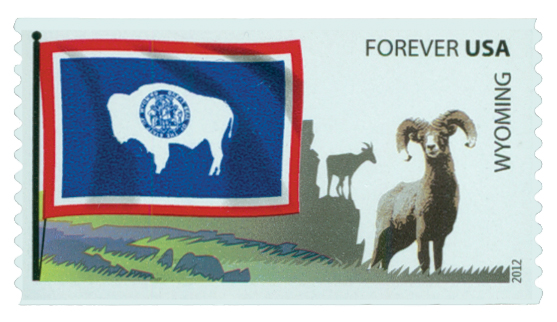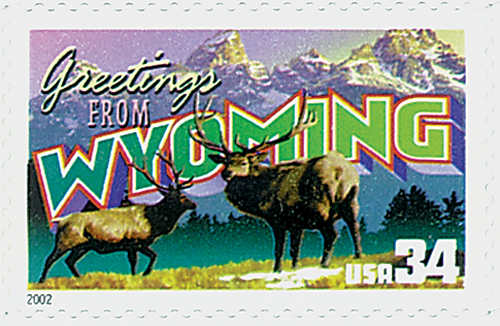
# 3610 FDC - 2002 34c Greetings From America: Wyoming
Wyoming
34¢ Greetings From America
City: New York, NY
Quantity: 200,000,000
Printed by: American Packaging Corp for Sennett Security Products
Printing Method: Photogravure
Perforations: Serpentine Die Cut 10.75
Quantity: 200,000,000
America’s First Female Governor Elected
On November 4, 1924, Wyoming elected Nellie Tayloe Ross America’s first female governor, again proving its nickname, “The Equality State.”
Wyoming has a proud tradition of leading the nation in women’s rights issues. Wyoming women were the first American women to vote, hold public office, and serve on juries. Women were granted these rights when Wyoming became a territory in 1869. In 1870, Esther H. Morris became our nation’s first woman justice of the peace in Wyoming. When Wyoming became a state in 1890, it became the first women’s suffrage state.

Nellie Tayloe Ross never intended to be a politician, though she was an ambitious woman. Growing up in Missouri and Kansas, her family had suffered major losses during the Civil War and struggled for many years. By the time she married lawyer William Ross in 1902, Nellie hoped to have a more stable life. But William accrued a lot of debt and wanted to enter politics. Though Nellie tried to talk him out of a political career, she supported him when he was elected governor of Wyoming in 1922. William frequently consulted Nellie on political issues and she was excited to discuss them with him.

William’s health took a drastic turn in the fall of 1924, and he died on October 2. As the First Lady of Wyoming, Nellie held her composure at the public funeral. Upon returning to the governor’s mansion to be with her family, Nellie was met by the chairman of the state Democratic Committee. He asked if she would consider running for governor in her husband’s place in the election that was just a month away.

Nellie was conflicted. Her family and friends told her it was a bad idea, that it was a man’s job, and that a potential loss would be devastating. However, Nellie was still mourning her husband’s death and also needed the money to support herself and her children. Ultimately, she decided on October 14th to run, just 45 minutes before the deadline. Nellie didn’t campaign for herself, though her supporters did extensively.

On November 4, 1924, Nellie won the election by 8,000 votes – even more than her husband’s victory two years earlier. After her inauguration the following January, Nellie stated that she would continue three of her husband’s policies: spending cuts, state loans for farmers and ranchers, and prohibition. She also introduced eight proposals of her own: city, county, and school district budgets, state bank regulations, mineral royalties for schools, improved safety for coal miners, and cutting back on child labor, among other issues. However, she was a lone Democrat surrounded by Republicans who opposed many of her ideas. But they did support five of her proposals.
Nellie became a national figure as the first female governor and spent much of the next two years delivering speeches. She narrowly lost the election of 1926, but went on to serve as the first female director of the U.S. Mint.
Wyoming
34¢ Greetings From America
City: New York, NY
Quantity: 200,000,000
Printed by: American Packaging Corp for Sennett Security Products
Printing Method: Photogravure
Perforations: Serpentine Die Cut 10.75
Quantity: 200,000,000
America’s First Female Governor Elected
On November 4, 1924, Wyoming elected Nellie Tayloe Ross America’s first female governor, again proving its nickname, “The Equality State.”
Wyoming has a proud tradition of leading the nation in women’s rights issues. Wyoming women were the first American women to vote, hold public office, and serve on juries. Women were granted these rights when Wyoming became a territory in 1869. In 1870, Esther H. Morris became our nation’s first woman justice of the peace in Wyoming. When Wyoming became a state in 1890, it became the first women’s suffrage state.

Nellie Tayloe Ross never intended to be a politician, though she was an ambitious woman. Growing up in Missouri and Kansas, her family had suffered major losses during the Civil War and struggled for many years. By the time she married lawyer William Ross in 1902, Nellie hoped to have a more stable life. But William accrued a lot of debt and wanted to enter politics. Though Nellie tried to talk him out of a political career, she supported him when he was elected governor of Wyoming in 1922. William frequently consulted Nellie on political issues and she was excited to discuss them with him.

William’s health took a drastic turn in the fall of 1924, and he died on October 2. As the First Lady of Wyoming, Nellie held her composure at the public funeral. Upon returning to the governor’s mansion to be with her family, Nellie was met by the chairman of the state Democratic Committee. He asked if she would consider running for governor in her husband’s place in the election that was just a month away.

Nellie was conflicted. Her family and friends told her it was a bad idea, that it was a man’s job, and that a potential loss would be devastating. However, Nellie was still mourning her husband’s death and also needed the money to support herself and her children. Ultimately, she decided on October 14th to run, just 45 minutes before the deadline. Nellie didn’t campaign for herself, though her supporters did extensively.

On November 4, 1924, Nellie won the election by 8,000 votes – even more than her husband’s victory two years earlier. After her inauguration the following January, Nellie stated that she would continue three of her husband’s policies: spending cuts, state loans for farmers and ranchers, and prohibition. She also introduced eight proposals of her own: city, county, and school district budgets, state bank regulations, mineral royalties for schools, improved safety for coal miners, and cutting back on child labor, among other issues. However, she was a lone Democrat surrounded by Republicans who opposed many of her ideas. But they did support five of her proposals.
Nellie became a national figure as the first female governor and spent much of the next two years delivering speeches. She narrowly lost the election of 1926, but went on to serve as the first female director of the U.S. Mint.













